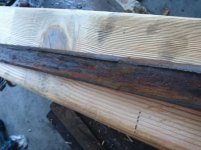I am working on a older (1965) j head machine and am stalled out waiting for some help. I am wondering if I can keep going or if that is going to be a problem later.
Details:
When I got it, the knee was frozen hard, the gib was snapped off, and there was a mildly terrifying amount of gook in all the ways. Long story short, I got the gib pieces out. Here is a picture of the largest one for reference:

Clearly the machine had not been getting the love and care that it needed. I ended up tearing the knee all the way down, cleaned, stripped, and repainted it, put in a new lift nut and screw, and picked up a new gib.
As we all know, the new gib needs fitting. I don't have the skills for that yet, but I am working with someone to get some help doing it. The issue is that their schedule is booked up for a couple months. I am wondering if I can keep going on getting it put back together (saddle, leadscrews, new bearings, etc) in the meantime, or if I need to get that gib fitted before I put anything else on.
At the moment, I have it sitting on the lead screw with the gib lubed up and inserted far enough to keep the knee from rocking. My concern with putting the saddle back on and continue assembly is that the added weight might mess up the gib fitting process. On the other hand, if putting that weight on affects the geometry or loading of the gib that much, then maybe I need to get it back together before the fitting.
Anyone have advice on this?
Details:
When I got it, the knee was frozen hard, the gib was snapped off, and there was a mildly terrifying amount of gook in all the ways. Long story short, I got the gib pieces out. Here is a picture of the largest one for reference:

Clearly the machine had not been getting the love and care that it needed. I ended up tearing the knee all the way down, cleaned, stripped, and repainted it, put in a new lift nut and screw, and picked up a new gib.
As we all know, the new gib needs fitting. I don't have the skills for that yet, but I am working with someone to get some help doing it. The issue is that their schedule is booked up for a couple months. I am wondering if I can keep going on getting it put back together (saddle, leadscrews, new bearings, etc) in the meantime, or if I need to get that gib fitted before I put anything else on.
At the moment, I have it sitting on the lead screw with the gib lubed up and inserted far enough to keep the knee from rocking. My concern with putting the saddle back on and continue assembly is that the added weight might mess up the gib fitting process. On the other hand, if putting that weight on affects the geometry or loading of the gib that much, then maybe I need to get it back together before the fitting.
Anyone have advice on this?

